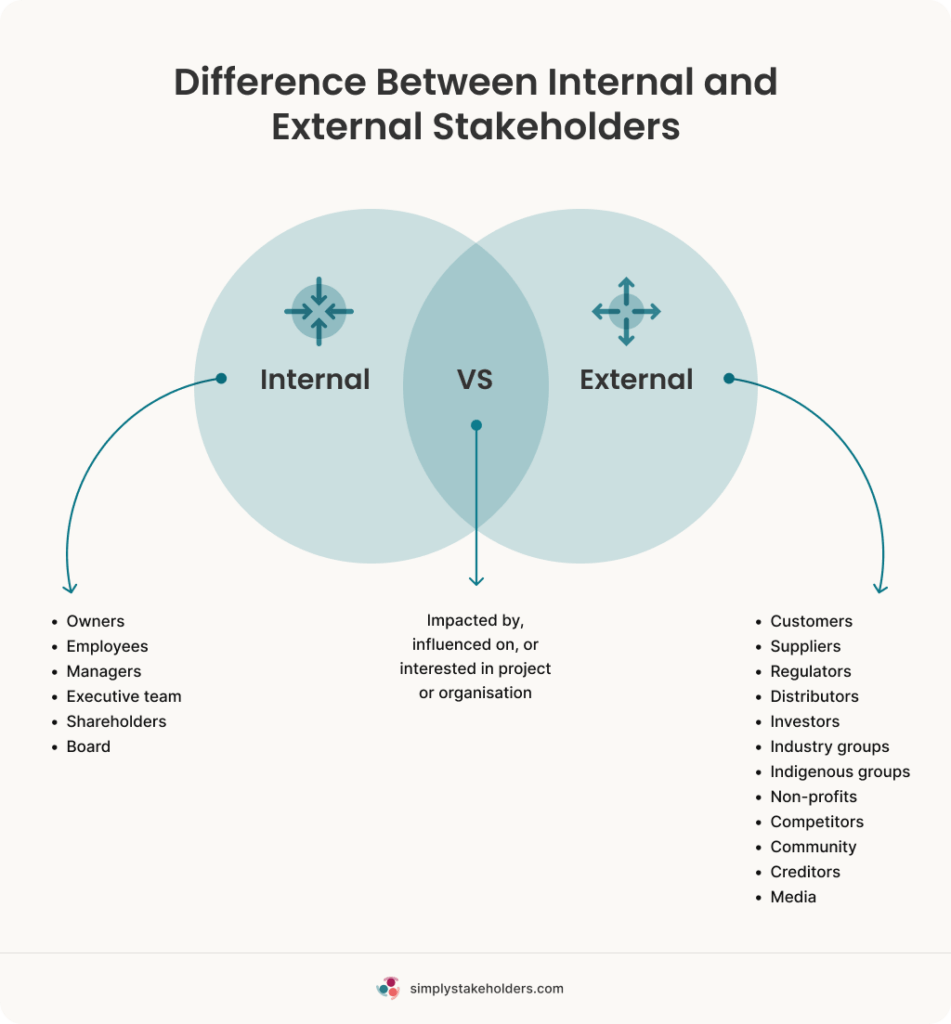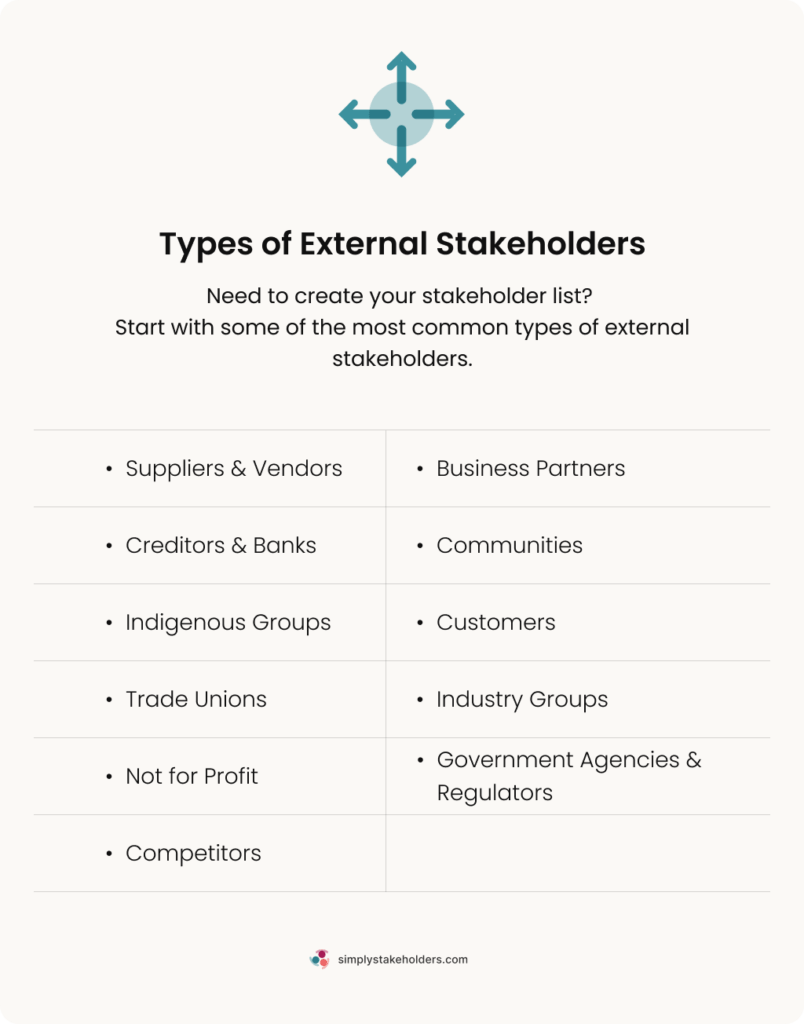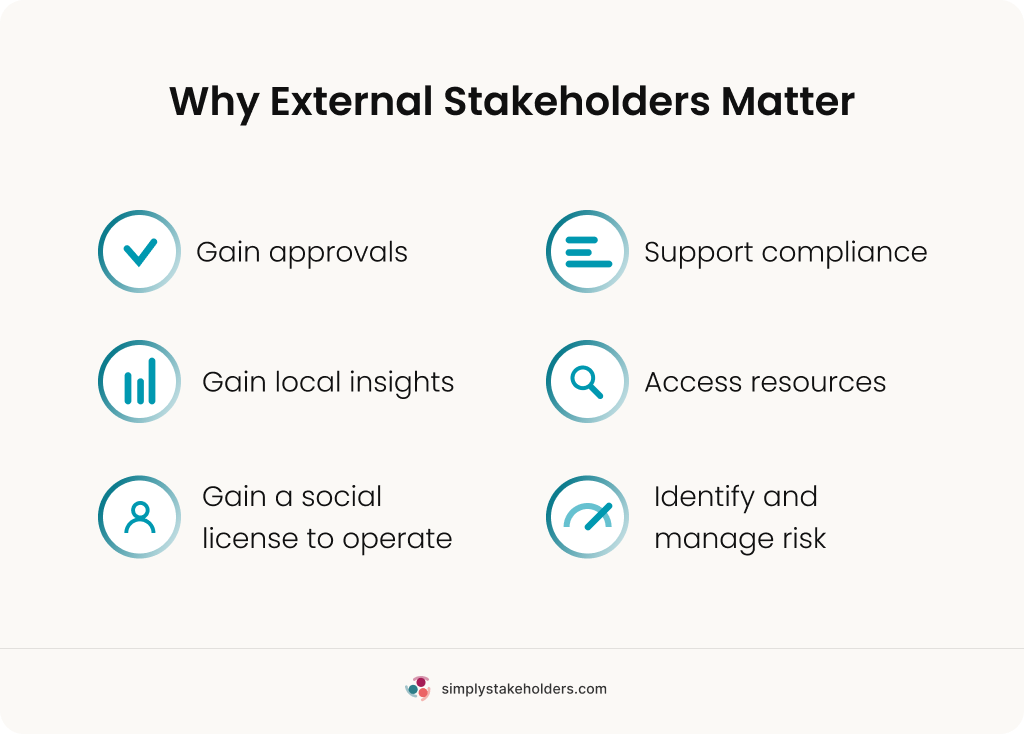Understanding External Stakeholders: A Brief Guide

One of the most common ways to categorize a list of stakeholders is by splitting them into “internal” and “external” stakeholders. This can sometimes be a useful starting place for determining different messaging and approaches for engaging with your stakeholders.
But who are your external stakeholders? And why are they important for your organization or project?
In this guide, we shine the light on what external stakeholders are (and what they’re not) and why they matter for organizations. Plus, we share a list of common types of external stakeholders and how you might engage with them.
What Are External Stakeholders?
Stakeholders are the people, groups, and organizations that are impacted by, or have an influence on, or an interest in your project or work. External stakeholders are those that operate outside of your organization, such as suppliers, creditors, community members, business partners, and regulators.
Despite operating externally, this group may still experience some impacts and risks due to the organization or project, and they may also hold the power to impact its outcomes. For example, they could:
- Oppose/support the project
- Buy from the business (or its competitors)
- Hold the business accountable to social expectations, industry standards, or legal obligations
Difference Between Internal and External Stakeholders

The remainder of your stakeholders operate within your business — these are referred to as internal stakeholders. This may include the business owners, shareholders, members of the board, the executive team, and your employees and their managers.
There are some key differences between internal and external stakeholder groups, such as:
- Their relationship with the business
- Their level and type of financial investment
- The types of effects they are likely to experience from the success (or failure) of the organization or project
And of course, the list of potential external stakeholders is typically much larger and more varied than the list of internal stakeholders (these remain the same for nearly every business and project).
12 Examples of External Stakeholders

Not sure where to start with your own list of external stakeholders? Read through the following examples and their key considerations when it comes to managing or engaging with these types of stakeholders in business.
Suppliers & Vendors
Your suppliers and vendors can have considerable impacts on your organization — without their support and cooperation, you’ll struggle to meet your commitments. It’s important to build solid relationships with these stakeholders — as well as potential future suppliers to help mitigate risk. Suppliers should be treated as valued partners, and given opportunities to provide feedback on any changes that may impact them. In addition, clear and regular communication about any changes, expectations, payments, processes, and timelines will help to keep these external stakeholders in the loop and responsive to your needs.
Business Partners
If you need to partner closely with other businesses in order to deliver your product, service, or project, you’ll need to build, manage, and maintain your relationships with these stakeholders. Depending on how your partnership works, you’ll need to communicate expectations, goals, structures, and reporting processes so that you can collaborate effectively. Before making a decision that may impact your business partners, consult with them to understand the impact and resolve any potential conflicts ahead of time.
Creditors & Banks
Both banks and creditors have a financial stake in the business or project — they are most interested in your financial performance and how you are managing any issues that could put their money at risk. You’ll need to keep these stakeholders up-to-date with regular reports on finances, timelines, and anything else that may be relevant. Regular and transparent communication could also help your case if you need additional funding or to negotiate different terms.
Communities
Most of the time, local communities are both impacted by and can have an impact on a project or organization. Community engagement is key to understanding this impact, gaining social acceptance, and benefiting from the knowledge and perspectives the local community has to offer. This may involve a variety of methods, such as letterbox drops, events, focus groups, surveys, emails, SMS updates, social media, and more. The key is regular communication and updates, ensuring community members have sufficient opportunities to have a say on the project.
Indigenous Groups
It’s also important to consider your project or organization through the eyes of local indigenous people, first nations groups, and their representatives. By respectfully and meaningfully engaging with these external stakeholders, you can gain an understanding of rights, culture, territorial claims, traditions, heritage sites, and how your project may interact with these issues. Focus on building trust-based relationships through open communication, and partnering with indigenous groups to find solutions together.
Customers
It can be easy to forget that your customers or clients are also your stakeholders. But they too will be impacted by the actions of your business — and can also have an impact on your business through their buying choices and any opinions they publicly express. This means that some of your customer communication should be less focused on sales and marketing, and more focused on engagement. Engaging with your customers may involve gathering feedback about decisions that may impact them via emails, surveys, or focus groups. It’s also a good idea to monitor social media and other online platforms for brand mentions so that you can better understand customers’ sentiments and needs, respond appropriately, and manage your brand’s reputation.
Trade Unions
Many organizations are impacted by the trade unions that represent their employees. Engaging with these stakeholders is important to build trust and avoid potential misunderstandings. This can involve establishing formal communication channels and grievance procedures, as well as consulting with unions early in the process when introducing operational changes that impact members.
Industry Groups
It’s often worthwhile engaging with industry groups to keep abreast of the latest trends and changes that may impact you. Likewise, you may be able to share valuable information with these groups to help inform best practices and regulatory change. Inside industry groups, you’ll also find opportunities to network and build relationships with other businesses and stakeholders.
Government Agencies & Regulators
Consider the different levels of government your organization and project may be impacted by, as well as the different regulatory bodies that set standards for your industry. These external stakeholders are concerned with reporting, health & safety, fair practices, and local laws. It’s a good idea to build relationships with government stakeholders to ensure you stay in the loop with any updates that may impact you (and so that you can have a say in the public consultation process, as a stakeholder yourself!).
Not for Profit
Some organizations will benefit from engaging and even partnering with not-for-profits as part of their project. These stakeholders may help you establish connections within the community, and provide insights that can help to inform your decisions. You may discover opportunities to contribute resources to a local not-for-profit organization that will create more value for the community you’re operating within and help to build goodwill.
Competitors
Finally, it’s a good idea to view your competitors as external stakeholders that require regular monitoring — after all, your actions and their actions can impact both of your business operations. You may even collaborate with your competitors on a specific project, or to set industry standards and pursue public policy change that impacts your sector.
The Importance of External Stakeholders

External stakeholders each have a separate but important role to play in your organization. This may include:
- Approvals – Many stakeholders have a statutory role in your process, such as approvals
- Compliance – In some cases, engaging with external stakeholders is a legal requirement
- Insights – You can discover more about how the project may impact stakeholders, as well as insights about the local culture, community, and environment that help make the project more sustainable and more likely to succeed
- Resources – Some external stakeholders may be able to share resources that help to improve the project, save on costs, and build social capital
- Social License – By engaging with local community members, indigenous groups, and not-for-profits, the organization is more likely to gain a social license to operate
- Risk – External stakeholder engagement can lead to better and earlier risk identification, and risk mitigation measures (including carefully managing stakeholders that could have a greater impact on outcomes)
It’s clear that very few projects could succeed without the input and cooperation of a number of external stakeholders.
Effectively Identify and Manage Your External Stakeholders
How you approach your external stakeholders will have a significant impact on your business or project. This starts with stakeholder identification and stakeholder analysis, and continues through to planning and implementing your external engagement and managing your stakeholders.
Looking for a tool to support all these steps and more? Simply Stakeholders is perfect for tracking and managing all your stakeholders in one place, with built-in analysis, mapping, task management, reporting, and more!
Check out Simply Stakeholders or reach out to our team to request a demo.






























